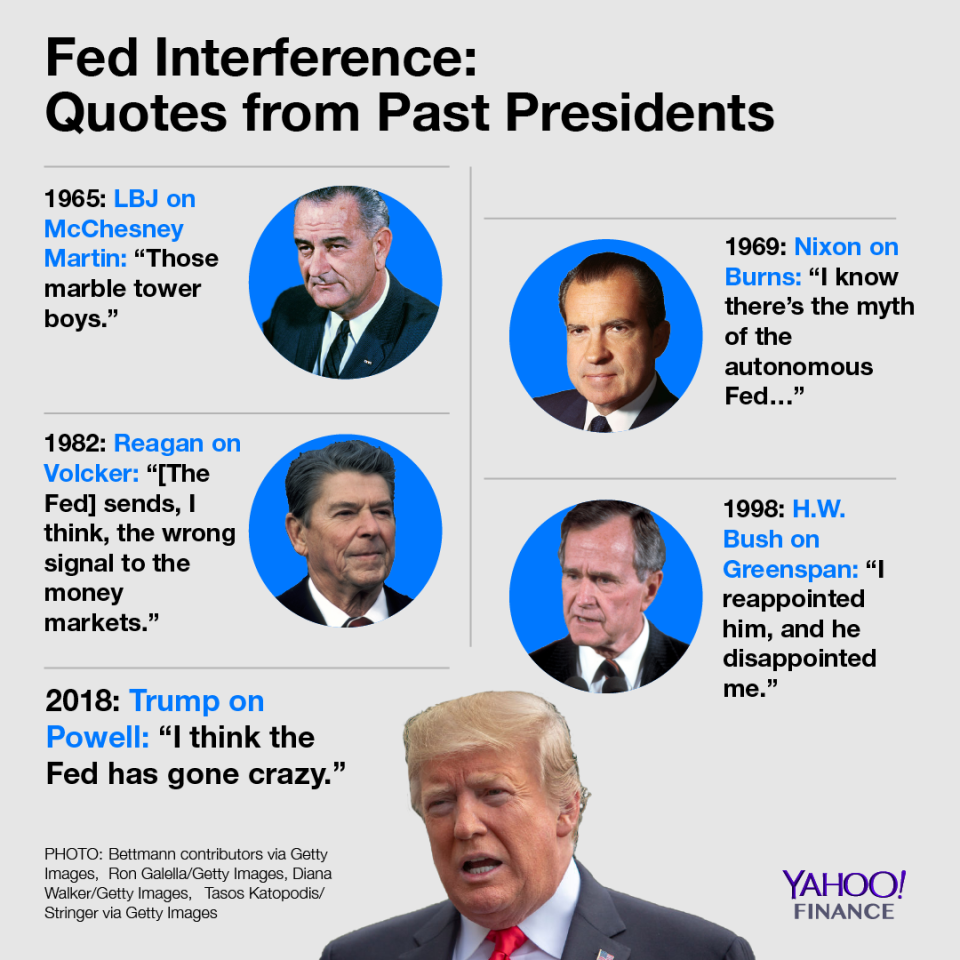Trump revives White House tradition of scapegoating the Fed
For the third day in a row, President Donald Trump slammed the Federal Reserve for raising interest rates. After saying that the Fed has “gone crazy” with its rate hike path, Trump told “Fox & Friends” Thursday that the sharp market dip on Wednesday was the result of the Fed “getting a little bit too cute” with monetary policy.
Although the last three presidents were largely silent on the Fed, the White House has had a history of blaming the independent central bank for political reasons over the past 60 years. In Trump’s case, the administration is trying to tout a strong economy ahead of a critical mid-term election. Trump hopes to attribute any market sell-off to the Fed’s monetary policy.
Aaron Klein, a fellow at the Washington, D.C.-based Brookings Institution, said that presidents going back to Lyndon Johnson have publicly attacked the Fed, noting that Trump’s personality makes it even more appropriate that he would be targeting Fed Chair Jerome Powell.
“Part of Trumpism is its never his fault,” Klein said.
“Those marble tower boys.”
The Fed saw its greatest political pressure in the 1960s, when administrations eager to advance their economic agendas attempted to directly influence the Fed.
In 1965, President Lyndon Johnson was worried that higher rates would dampen the effect of his “Great Society” welfare programs and tax cuts. Knowing that the Fed Chair and the Treasury Secretary regularly chat — a tradition that still exists — Johnson instructed then-Secretary Joe Fowler to advise Fed Chair William McChesney Martin Jr. to delay a rate hike.
Martin hiked rates anyway, after which Johnson fumed to Fowler.
“Those marble tower boys. Joe, you find a tough guy to head the Reserve,” Johnson said, as chronicled in Robert Bremmer’s book, “Chairman of the Fed.” “If Martin resigns, it won’t wreck the country.”
Martin did not resign, and remained chair through the end of his term in 1970.
President Richard Nixon was more forthright in its intentions with the Fed. Days after Nixon announced that White House adviser Arthur Burns was his pick to head the Fed, Nixon told Burns that their relationship would “be different than they were with Bill Martin there.”
The Nixon tapes revealed that the president had direct lines of communication with Burns; days before the December 1971 Federal Open Market Committee meeting, Burns spoke with Nixon over the phone and informed him that the central bank would be lowering the discount rate.
Nixon was able to get Burns to engineer an expansionary monetary policy leading up to the 1972 election, when Nixon won a second term.

‘He disappointed me.’
The presidents that followed Nixon adopted a softer approach to Fed criticism,
In 1982, President Ronald Reagan took issue with Fed Chair Paul Volcker’s tight monetary policy, believing that his controls on the money supply were stalling out high interest rates. Reagan feared that Volcker was blocking businesses from taking advantage of his tax cuts.
But Reagan used milder language, saying the Fed “sends, I think, the wrong signal to the money markets,” as The New York Times reported. Reagan added that “there’s a little caution at work.”
President George H.W. Bush also clashed with the Fed four months before the 1992 election, when he sought to lift a lagging economy struggling to recover from a postwar recession. He told The New York Times that he would “like to see another lowering of interest rates.” Fed Chair Alan Greenspan, appointed by Reagan, followed through that July, cutting the discount rate from 3.5% to 3.0%.
But Bush felt like he needed a more dramatic cut in rates. In 1998, Bush said if interest rates were lower than Greenspan allowed, he would have won the election instead.
“I reappointed him, and he disappointed me,” Bush told The Wall Street Journal.
Powell Pinata
Trump’s comments against the Fed, while more frequent, appear to be in line with criticisms of past presidents. Trump even echoed Bush’s language by saying he was “disappointed” in Powell for his monetary policy decisions, as reported by Reuters on Thursday.
But Trump’s ability to capture headlines — in addition to his tendency to let passing thoughts fly on Twitter — presents an element of unpredictability for market observers.
Horizon Investment Chief Global Strategist Greg Valliere wrote in a note Thursday that Trump is framing Fed Chair Jerome Powell as a “new pinata” for an overheating economy.
“Many of Trump’s economic prescriptions invite inflation — so obviously the Fed has to take away the monetary punch bowl,” Valliere wrote.
Brian Cheung is a reporter for Yahoo Finance.
Read more:
